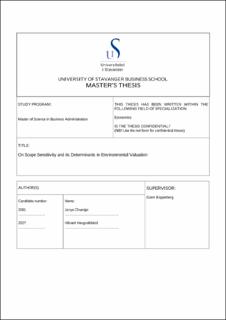| dc.description.abstract | This thesis investigates the determinants of sensitivity to the scope of damages caused by oil spills on an individual level. We examine the results of two contingent valuation (CV) surveys conducted in 2020 on Norwegians’ WTP to avoid oil spills in coastal areas, specifically Lofoten, and the Oslofjord. There is an ongoing debate regarding sensitivity to scope in stated preference (SP) studies in the field of environmental valuation reflecting on the apparent lack of adequate scope sensitivity in survey results. These results, at times showing low, or no sensitivity to scope are seen by some as problematic, arguing that such results are not consistent with rational choice. Scope sensitivity results have consequently been regarded as a validity check for SP studies. Using the elicited WTP amounts from the two CV studies we attempt to analyze the causes of scope sensitivity/insensitivity by creating scope arc-elasticities for each respondent. In our regression analysis, we use scope elasticities as a measure of scope sensitivity in a set of generalized linear panel models.
The sample mean elasticities range from 0.17 to 0.25 in Lofoten, while in the Oslofjord the sample mean elasticities range from 0.46 to 0.57 depending on the model. We find that a significant proportion of respondents are not sensitive to scope, and some respondents have negative scope elasticities. Our estimates of scope elasticities are fairly in line with results from previous studies, and suggestions of adequate sensitivity results. We find that specific results of scope sensitivity determinants often vary across the surveys and models used in our analysis. Household income is found to be statistically significant across all models, and positively affects scope elasticities. Other demographic and socio-economic variables are also observed to affect the respondent’s sensitivity to scope. Examining the effects of use/non-use values we find largely non-significant or mixed results. Regarding the attitude determinants of scope sensitivity, we find mixed results, however a strong indication of a relationship between sensitivity to scope and membership of an environmental organization is observed in the Lofoten data. We cannot properly establish a relationship between a location being regarded as iconic affecting its scope elasticity. Findings also suggest the abnormal conditions caused by the COVID-19 situation have affected respondents’ scope sensitivity, specifically those suffering a negative impact on their level of happiness compared to pre-pandemic conditions. This also indicates that emotions play a role in non-market valuation. We recommend further studies be conducted into the determinants of scope sensitivity on an individual level. | |
